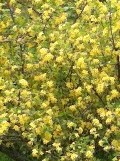 Clove current is a deciduous shrub native to central United States and a member of the gooseberry family, Grossulariaceae. It is loosely branched and irregularly shaped and may develop an untidy look over time but can be rejuvenated by heavy pruning. Plants produce suckers and form clumps or colonies unless the suckers are removed. Clusters of small, nodding, yellow male and female flowers are produced on different plants in spring. The flowers are trumpet-shaped, have a strong spicy-sweet, clove fragrance, and attract both butterflies and hummingbirds. Female flowers are followed by shiny black edible berries that are appealing to wildlife and humans. The bluish-green leaves are oval to rounded and have 3-5 lobes. In the fall the leaves turn yellow mixed with red and are moderately showy. Plants are drought tolerant. Clove current is a good choice for naturalistic plantings, a hedge or screen, and is especially attractive set against evergreens that accentuate the yellow flowers. It is the alternate host of white pine blister rust and is restricted in states that have this problem. The genus name, Ribes, comes from the Arabic or Persian name ribas, meaing acid-tasting. The specific epithet, odoratum, is the Latin word meaning fragrant.
Clove current is a deciduous shrub native to central United States and a member of the gooseberry family, Grossulariaceae. It is loosely branched and irregularly shaped and may develop an untidy look over time but can be rejuvenated by heavy pruning. Plants produce suckers and form clumps or colonies unless the suckers are removed. Clusters of small, nodding, yellow male and female flowers are produced on different plants in spring. The flowers are trumpet-shaped, have a strong spicy-sweet, clove fragrance, and attract both butterflies and hummingbirds. Female flowers are followed by shiny black edible berries that are appealing to wildlife and humans. The bluish-green leaves are oval to rounded and have 3-5 lobes. In the fall the leaves turn yellow mixed with red and are moderately showy. Plants are drought tolerant. Clove current is a good choice for naturalistic plantings, a hedge or screen, and is especially attractive set against evergreens that accentuate the yellow flowers. It is the alternate host of white pine blister rust and is restricted in states that have this problem. The genus name, Ribes, comes from the Arabic or Persian name ribas, meaing acid-tasting. The specific epithet, odoratum, is the Latin word meaning fragrant.
 Type: Deciduous shrub
Type: Deciduous shrub
Outstanding Features: Spring flowers
Form: Rounded to irregular
Growth Rate: Medium
Bloom: Clusters of small, yellow male and female flowers are produced on different plants in spring.
Size: 6-12′ H x 6-8′ W
Light: Full sun; tolerates some shade
Soil: Average, medium moist, well-drained
Care: Remove suckers when needed to control spread; cut back hard to rejuvenate when plant gets untidy.
Hardiness: Zones 4-7
Pests and Diseases: Anthracnose and leaf spot in moist humid conditions; susceptible to mildew, blight, currant aphid, scale, and currant bud mite.
Propagation: Seed, cuttings
Outstanding Selection: ‘Crandall’ (heirloom cultivar with larger berries and more disease resistance than species).
